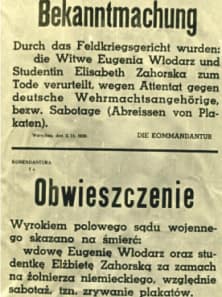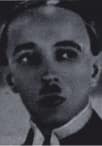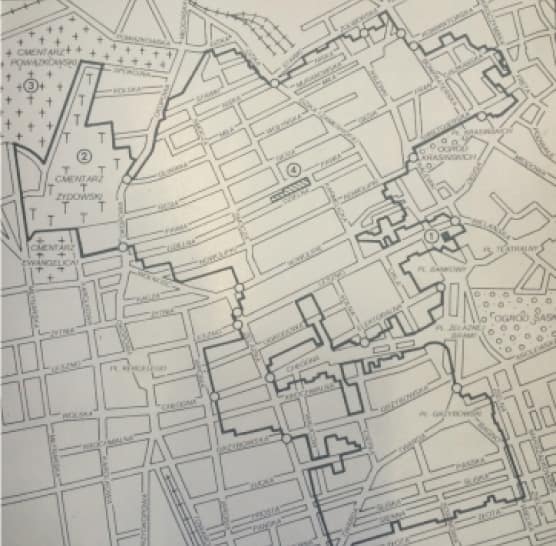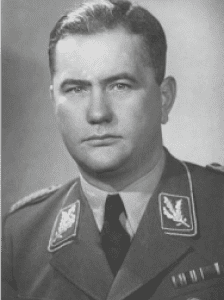First reprisals
Immediately after marching into Warsaw, the Germans used brutal terror against civilians living in the city. On October 8, 1939, they arrested 354 Warsaw-based Catholic priests and teachers, whom the occupying forces considered to be a “great threat”. A poster was placed on the walls of the city on November 3, 1939, announcing that Eugenia Włodarz – a widow – and Elżbieta Zahorska – a student – had been sentenced to death by court-martial for an “attack on a German soldier” and “sabotage and the tearing down of posters”. Elżbieta Zahorska was born on June 6, 1915. In 1939, she took up arms against the enemy. She was taken captive, but she soon escaped and a warrant for her arrest was issued. She was captured while tearing down a German propaganda poster which displayed a wounded Polish soldier pointing out his plundered homeland to the British Prime Minister. Zahorska was killed by firing squad in the Mokotów Fort. Before her execution, she shouted in German “Noch ist Polen nicht verloren” (“Poland hasn't died yet”).

Elżbieta Zahorska.

An execution of Polish people in Wawer, a Warsaw district.

A fragment of the symbolic cemetery which was created in 1949 at the site of execution on December 27 St. in Wawer.

An announcement.


In the period between December 7, 1939, and July 17, 1941, firing squads comprised of functionaries of SS units and the German Police executed over 1800 Polish citizens near the village of Palmiry on the verges of the Kampinos nature reserve. The victims were mainly of Jewish and Polish nationality, and most of them were transported from Warsaw prisons and jails. Among them were many representatives of the political or cultural elite, arrested in the so-called Action “AB”, directed against the intelligentsia. The operation was carried out by the General Government for the Occupied Polish Territories between May and June 1940, and its victims included more than 3,500 Polish people.
SS-Standartenführer Josef Meisinger, the Commander of the Secret Police and the Security Service, was responsible for completing the operation in the Warsaw area. He was sentenced to death by the National Court of Justice and executed on March 7, 1947, in the Mokotów Prison in Warsaw.

Maciej Rataj was born on February 19, 1884, in Chłopy. He was a rural activist, journalist and politician. Minister of Religious Affairs and Public Education (1920-1921) and Speaker of the Polish Parliament (1922-1928). Leader of the Polish People's Party (1936-1937, 1938-1939). He took part in the defense of Warsaw in September 1939, and then fought in the resistance. He was active in the Service for Poland's Victory, and helped in the creation of its Major Political Council. From February 1940, he was President of the People's Party “Roch”. Arrested by the Germans in 1940. Murdered on June 20 or 21, 1940, in Palmiry.

Janusz Tadeusz Kusociński was born on January 15, 1907, in Warsaw. A sportsman, teacher of physical education, coach and journalist. Olympic gold medalist in Los Angeles at the distance of 10 km (1932), silver medalist at the first European Championships at the distance of 5 km (1934). He took part in the defense of Warsaw in September 1939 and was wounded. A member of the resistance military organization “Wilki”. Arrested by the Germans on March 26, 1940, in Warsaw. Murdered on June 20 or 21, 1940 in Palmiry.

Women brought over to be executed are blindfolded.

Prisoners on the road through the woods before their execution.

Prisoners blindfolded before their execution.

Helena Maria Jaroszewicz was born on November 17, 1892, on the estate of Dziewanowo. She was an independence activist during World War 1; imprisoned by Russian authorities. Vice-President of the Civil Labor Union for Women in independent Poland, member of parliament (1930-1935), senator (1935-1938). After 1939, in the Underground Service for Poland's Victory (later the Union for Armed Struggle). Arrested by the Germans on April 15, 1940, in Warsaw. Murdered on June 20 or 21, 1940 in Palmiry.

Leon Fortunat Skuba-Pękosławski i was born on May 31, 1868 in Warsaw. A medical doctor and Orientalist. After World War 1, the Vice-President of the Polish Red Cross; activist in the Underground Cadre of Independent Poland, nom de guerre “Leon”. Arrested by the Germans in January 1942 in Warsaw.

Józef Walicki i was born on May 27, 1903. An officer of the Polish Army. Heavily wounded in the Battle of Bzura in September 1939. Later, he fought in the guerilla unit of Henryk Dobrzański “Hubal”, nom de guerre “Walbach”. He was promoted to the rank of Cavalry Officer. Finally, he joined the Union for Armed Struggle. Arrested by the Germans in Warsaw. Killed by firing squad on May 28, 1942.
Early in the morning of May 28, 1942, German SS soldiers killed 223 people, including 22 women, in a mass execution in the Sękocin Forest near the village of Magdalenka. The victims were prisoners from the Warsaw Pawiak Prison, mostly members of the resistance or representatives of the intelligentsia. In 1946, their remains were exhumed and buried in the cemetery in the nearby village of Łazy.
This was probably not the only execution to have been carried out by the Germans in this place. It has been proven that small groups of Poles (up to 10 people) were also murdered here. However, information obtained by the Home Army intelligence concerning the execution of 200 prisoners from the Mokotów Prison has not been verified. This incident was supposed to have taken place in the spring of 1942.
Responsibility for this crime must be attributed to the following 3 people: the General Governor of the Warsaw District, Ludwig Fischer, the SS and Police Commander in this district SS-Oberführer Ferdinand von Sammern-Frankenneg (a member of the German Reichstag, he died on September 20, 1944, fighting Yugoslavian guerrillas near Banja Luka), and SS-Standartenführer, Ludwig Hahn, the Commander of the Secret Police and the Security Service in Warsaw (in 1973, he was sentenced to 12-years of imprisonment which was commuted to a life sentence in 1975; he died a free man on November 10, 1986 in Hamburg).
The building at 25 Szucha Alley, which had been the location for the Ministry of Religious Affairs and Public Education before September of 1939, was taken over by the German secret services (it was the center of the so-called police district). Part of the building was occupied by the largest department of the Security Police, the Gestapo. The Sicherheitspolizei (security police) and Sicherheitsdienst (intelligence agency) for Warsaw and the Warsaw district also had their offices there. The building was a point of destination for prisoners from the Pawiak Prison (usually transported twice a day), as well as from other prisons of the Warsaw district, and newly arrested people. It is difficult to accurately estimate the number of victims put to death at 25 Szucha Alley. The scale of crimes committed there has been revealed by the extensive number of human remains and bones found in the cellars of the building, which have a total weight of 5.5 tons.
During World War II, the Pawiak Prison (Dzielna St.) was the largest German political prison in the territory of occupied Poland. Between October 1939 and August 1944, the prison received 100 thousand people, of whom approximately 37 thousand were murdered and 60 thousand were transported in 95 shipments to concentration camps. The Pawiak Prison was a place of permanent residence for about 3,000 prisoners, of whom 2,200 were kept in the men's jail and 800 in the women's jail (the so-called Serbia). In November 1940, the prison was taken over by the Gestapo. The mass executions in the Pawiak prison shocked the city of Warsaw. On the walls of the buildings, as well as on bulletin boards and pavements, graffiti appeared: „Pawiak pomścimy” [“We will revenge Pawiak”].

Władysław Karaś was born on August 31, 1893, in Kielce. During World War 1, he fought in the Polish Legions. After 1918, he served in the Polish Army, receiving the rank of Captain. A sportsman, he participated in the Olympic Games in Berlin in 1936. He won bronze medal in shooting. During World War 2, a member of the Union for Armed Struggle/Home Army, nom de guerre “Pankracy”. He served in the Revenge Units (Związek Odwetu). He was arrested by the Germans on April 23, 1942. Killed by firing squad on May 28, 1942. Posthumously promoted to the rank of Major.

Franciszek Kwieciński was born on September 13, 1884 in Głuszyn, near Nieszawa. A political activist. After World War 1, one of the most prominent activists of the National Workers Party, and one of the founders of the Labor Party. During World War 2, a representative of the Labor Party on the Main Committee for Political Consensus Agreement at the Union for Armed Struggle. Arrested by the Germans on January 19, 1942. Killed by firing squad on May 28, 1942.



An announcement from December 1943, with information about an execution of 100 prisoners.

An inscription on one of Warsaw's streets.

Pawiak in 1945 r.
On the night between October 7 and 8, 1942, seven patrols of the Home Army soldiers under the command of Captain Zbigniew Lewandowski, nom de guerre “Szyna”, performed an action of sabotage on the Warsaw railway junction (operation “Wieniec”). Without incurring any casualties, they tore the rails from the railroads all around Warsaw, derailing several trains. This paralyzed German railway traffic to the eastern front – including transport to Stalingrad – for a couple of days.
In retaliation, being unable to identify the perpetrators, the German occupying authorities decided to organize public executions in Warsaw for the first time. At dawn on October 16, 50 prisoners from Pawiak were hanged on five gallows located in different parts of the city: 10 on each gallows. The gallows were located:
– in the Wola district, near the grade crossing at Mszczonowska St.
– near railway tracks in the Szczęśliwice neighborhood,
– at the corner of Toruńska St. and Wysockiego St., in the Pelcowizna neighborhood,
– in the Rembertów district at the railway station,
– in the town of Marki, near the tracks of the suburban railway.

An announcement about an execution of 50 prisoners from the Pawiak Prison on October 16, 1942.

Victims executed by hanging in Szczęśliwice.

Victims executed by hanging in Wola district.

Victims executed by hanging in Szczęśliwice.

Stanisław Henryk Święcicki was born on February 28, 1897. An attorney, Deputy Dean of the Warsaw Bar Association. In September 1939, the chief of security at the Civil Defense Committee of the Praga district. Later, he was active in the Union for Armed Struggle. He participated in the work of the Polish government-in-exile. Arrested by Germans on May 11, 1942, in Warsaw. Executed on October 16, 1942.

Mieczysław Szawalewski was born on October 19, 1887, in Krosno. He defended Lwów in 1918. A lawyer, diplomat, Vice-Consul at the Consulate General of the Republic of Poland in New York. Later, an academic teacher at the School of Political Sciences in Warsaw, member of parliament (1930-1935). During World War 2 he joined the Union for Armed Struggle. He worked for the Polish government-in-exile. He was arrested by the Germans on the night of June 3, 1942, in Warsaw. He was executed on October 16, 1942.






































































